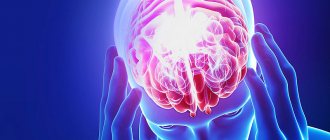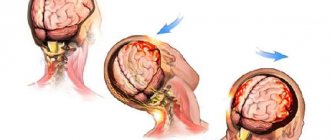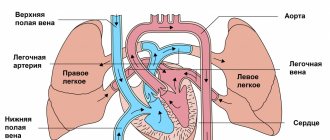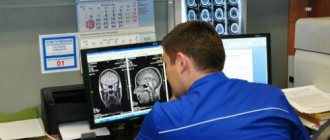☝ Brain injury or TBI produces a wide variety of, sometimes severe, consequences. Preventing the consequences of TBI is important for preventing the development of mental illnesses. Prevention and early diagnosis of the consequences of brain injury is one of the main specializations of our rehabilitation medicine clinic.
Our therapeutic methods of restorative medicine in neurology have the ability, in the shortest possible time, not only to prevent consequences, but also to restore most of the processes disrupted by TBI.
We help in the most difficult situations, even when previous therapy did not help. This is achieved by using an individually adapted technique developed by Brain Clinic specialists and approved for use by the international ethical committee of medicine.
The best treatment is prevention. But emergency assistance, provided on time and correctly, gives good results.
Possible symptoms of a concussion
- Brief confusion or loss of consciousness. With a strong blow, the moment of injury disappears from memory.
- Dizziness even at rest, and when turning, bending or other changes in body position, the symptom intensifies.
- Severe headache, nausea and vomiting.
- Double vision, inability to concentrate on one point.
- Increased sensitivity to light and sounds.
- Impaired coordination of movements.
- Reaction inhibition - the victim gives an answer to the question after some time.
- Pale skin, weakness, sweating.
Important! A concussion is not always accompanied by visible head injuries, so the absence of wounds does not exclude brain injury.
First aid in case of cerebral edema
In case of a traumatic brain injury, first aid should be provided to the person as quickly as possible. Emergency care gives a person a chance to save life. There is even a possibility that the victim will be able to lead a full life. The injury itself may not have a negative impact on the body, but subsequent factors can lead to the fact that a person may become disabled, and in the worst case, die. These factors include:
- breathing problems;
- strong surges in intracranial pressure;
- state of shock.
It should be taken into account that cerebral edema does not develop immediately in all cases. Therefore, the emergency care provided must be carried out taking into account the fact that the injury received is regarded as serious, that is, taking into account the fact that it can lead to complications of various kinds, up to and including the death of the patient. The victim must be urgently taken to the nearest medical facility, observing safety precautions during transportation.
What should a person without medical skills do in such a situation? Try not to panic, concentrate and immediately call an ambulance. Only after this should first aid begin. It will consist of maintaining respiratory function; if necessary, indirect cardiac massage and artificial respiration are performed. Ice should be placed on the person's head to reduce blood flow. If possible, a decongestant (Lasix) should be administered.
//youtu.be/a2mOnvQjVUY
First aid for concussion
- If one or more symptoms are present, immediately call an ambulance or take the victim to a doctor.
- Treat a wound on the head if it appears as a result of an impact.
- For an hour or until the doctor arrives, it is important not to fall asleep, but to remain at rest.
- If you lose consciousness, lay the person on his side, bend his knees, and put his hands under his head.
- If symptoms of a concussion do not immediately appear, it is recommended to rest and not begin vigorous activity.
Does an MRI show a concussion?
Using this method, the brain substance is visualized with a minimum slice thickness of one millimeter. This technology has gained great popularity due to its high resolution. When using it, the doctor quickly receives an accurate image, allowing him to draw the right conclusions and take the necessary actions aimed at treating the patient. In case of a concussion, MRI can determine the following parameters:
- brain structure;
- the size and location of certain areas;
- the presence of various neoplasms;
- current state of blood vessels, etc.
If there is no anatomical damage to the organ after injury, an MRI will demonstrate the normal state of the tissue. In such cases, the computed tomography method is more informative. With its help, you can determine a ruptured vessel, hematoma (accumulation of blood), fracture of the skull bones and many other pathological changes. The above complications can occur due to compression or contusion of the brain.
In what cases after an injury is it necessary to do an MRI of the brain?
Specialists in the acute period of injury usually advise patients to do a CT scan. Using computed tomography, you can assess the severity of damage, examine the condition of the organ, and determine the optimal treatment tactics. Computed tomography is prescribed to patients if they have signs of a concussion, if various injuries to the neck and head, and bruises are detected during a visual examination of the victim. MRI for TBI is prescribed only weeks or months after the incident, if the patient continues to have the following complaints:
- systematic dizziness;
- increased sweating;
- memory impairment, decreased concentration;
- severe unsteadiness of gait, etc.
Young children and the elderly usually have different symptoms. After the blow, they may not lose consciousness. Children are characterized by changes in activity, increased regurgitation, and drowsiness. Elderly people usually complain of changes in cognitive functions and decreased concentration. It can be difficult for children and the elderly to determine for themselves the force of a head blow and the severity of the consequences, so their condition must be monitored very carefully. In case of such an incident, elderly people undergo a CT scan, and infants undergo an X-ray of the skull and ultrasound of the brain. An MRI is prescribed if symptoms persist two weeks after the incident.
People over eighteen years of age who are admitted to the hospital with a suspected head injury are given a CT scan. This diagnostic method is highly informative regarding intracranial hemorrhages, bleeding, and skull fractures. Computed tomography is performed quickly, which is very important, because in severe injuries, minutes often count. When the danger to the victim’s life disappears, he may be prescribed an MRI to clarify the condition of the brain structures. Dynamics are usually assessed six months after injury or before reconstructive surgery.
Recommendations for the treatment of concussions
If hospitalization is not required, with the permission of a doctor, a mild concussion can be treated at home:
- Bed rest and rest are required, no work. Long sleep is very important.
- You cannot read, watch TV, play computer games or use gadgets.
- Under no circumstances should you play sports.
- You are allowed to listen to music, but not through headphones.
- You can use herbal sedative drops or herbal infusions.
- In your diet, you should give preference to dairy and plant products, limit salt intake - to prevent increased pressure, including intracranial pressure.
If the patient seeks medical help in a timely manner and all recommendations are followed, recovery will occur quickly and without complications.
Mild brain contusions
They are not accompanied by a threat to life and manifest themselves with the following symptoms:
- loss of consciousness, lethargy, drowsiness, memory loss;
- dizziness, vomiting;
- changes in heart function, increased blood pressure;
- neurological disorders (tremor of the eyeballs, lack of pupillary response to light, decreased muscle tone, anisocoria);
- meningeal symptoms (neck muscle tension, Brudzinski and Kernig symptoms).
There are no serious consequences for mild brain contusions. The prognosis for the patient is favorable. Symptoms disappear within 3 weeks.
Main services of Dr. Zavalishin’s clinic:
- consultation with a neurosurgeon
- treatment of spinal hernia
- brain surgery
- spine surgery
Baby went
Special socks with “brakes” (these are rubberized inserts in the sole of the sock that reduce slipping) can protect your child from falling in the apartment. They are especially useful in an apartment with parquet floors. Place rugs in places where your baby usually travels (but so that they lie tightly and do not slide on the floor). For the first time, wrap some thick material around the sharp corners of furniture and door jambs. Remove chairs and other furniture from the windows - this will keep an inquisitive little person from wanting to climb onto the windowsill or, scary to think, open the window.
Children under one year old
Babies most often roll onto the floor from changing tables, so you need to swaddle your baby not on the table, but, for example, on the sofa. He's shorter. Also, to cushion a possible fall, place a rug under a table or next to a sofa. Three more simple recommendations:
- do not take your eyes off the baby for a second while swaddling;
- try to hold it with your hand;
- If you need to go away (to get a bottle, or pick up the phone, or open the door), take the baby with you. Otherwise, he can turn over from his back to his stomach at any moment (it’s better not to think about the consequences of such an acrobatic sketch).
You have to keep an eye on your baby even when he is lying peacefully in his crib. However, lying down is half the battle. As soon as he starts to sit down, keep your eyes open. If your fidget has already mastered the art of sitting, urgently buy a low, stroller. And definitely one in which the child can sit and lie. It is more difficult for him to get out of such a stroller, and it is safer to fall.
Severe brain contusions
Such an injury poses a threat to human life. The consequences of a severe brain injury are serious, and recovery takes several months. Often the victim never fully recovers.
The following signs indicate a severe brain injury:
- loss of consciousness, after which the person is in stupor or a state of stupor;
- temperature rise to 41°C;
- psychomotor agitation, convulsive syndrome;
- disturbances in the respiratory and circulatory system (up to the need for artificial ventilation);
- neurological symptoms (dilation or constriction of pupils, “floating” eyeballs, difficulty swallowing, paralysis, loss of speech);
- pronounced meningeal signs.
Severe brain effects regress extremely slowly. Recovery takes a long time. In some cases, the patient becomes disabled.
The most common consequences of brain contusions are:
- inflammation of the meninges;
- epilepsy;
- atrophy (decrease in tissue volume) of the brain;
- hydrocephalus accompanied by intracranial hypertension;
- scars on the meninges and tissues;
- cerebrospinal fluid cysts;
- post-traumatic porencephaly;
- liquorrhea (due to a skull fracture).
These conditions are accompanied by movement disorders, dizziness, impaired coordination, speech, mental disorders, headaches, decreased intelligence, and convulsive seizures.
Brain concussion
Concussion ranks first in the structure of traumatic brain injury in frequency - 70-80% of victims with TBI. In absolute terms, the number of victims with concussion annually reaches 350,000-400,000 people in Russia.
CLINICAL PICTURE
A concussion is characterized by short-term depression of consciousness - from several seconds to several minutes, often within the range of stupor (stupor). Sometimes disturbances of consciousness are subtle or even absent. Retrograde, congrade and anterograde amnesia are detected only for a very narrow period of events. Immediately after a TBI, one-time vomiting, some increased breathing, increased or slower heart rate are possible, but these indicators soon return to normal. Blood pressure quickly returns to the physiological norm, but in some cases it can increase more persistently, especially if the anamnesis is aggravated by hypertensive reactions or hypertension. This is due not only to the injury itself, but also to the stress factors that accompany it. Body temperature during a concussion remains normal. Characteristic is the “play of vasomotors” (pallor of the face is replaced by its hyperemia). Upon restoration of consciousness, typical complaints are headache, dizziness, weakness, tinnitus, flushing of the face, sweating and other vegetative phenomena, discomfort and sleep disturbance. Pain when moving the eyes, divergence of the eyeballs when trying to read, and vestibular hyperesthesia are noted. In the first hours after injury, a rapidly passing slight dilation or constriction of both pupils is possible, while maintaining vivid reactions to light. The neurological status often reveals labile, soft, variegated asymmetry of tendon and skin reflexes, small horizontal nystagmus in the extreme abductions of the eyes, and mild meningeal symptoms. The clinical picture of a concussion largely depends on age factors.
SYMPTOMS
Symptoms of a concussion largely depend on age factors. • In infants and young children, concussion often occurs without impairment of consciousness and is clinically characterized by the appearance of vegetative-vascular and somatic symptoms. At the time of injury - sharp pallor of the skin (primarily the face), tachycardia, then lethargy, drowsiness. Regurgitation occurs during feeding, vomiting, anxiety, sleep disorders, and dyspeptic symptoms are noted. All symptoms disappear within 2-3 days. • In young (preschool) children, a concussion can occur without loss of consciousness. Spontaneous horizontal nystagmus, decreased corneal reflexes, changes in muscle tone (usually hypotension), increased or decreased tendon reflexes, pulse lability, and sometimes low-grade body temperature are detected. Shell symptoms (mainly Kernig's sign) are rarely detected and are usually mildly expressed. The general condition improves within 2-3 days. • In elderly and senile people, primary loss of consciousness due to a concussion occurs much less frequently than in young and middle age. At the same time, severe disorientation in place and time often occurs, especially in victims with concomitant cerebral atherosclerosis and hypertension. Retrograde and congrade amnesia is found more often in the elderly and elderly than in young people. Headaches are often pulsating in nature, localized in the occipital region. The pain lasts from 3 to 7 days, differing in significant intensity in people suffering from hypertension. Dizziness is frequent, usually systemic, caused by changes in the vestibular apparatus and previous vascular insufficiency in the vertebrobasilar region. In a number of elderly and senile victims with a concussion, fairly clear focal symptoms are revealed that arise as a result of previously suffered diseases or their exacerbations after injury (for example, dynamic cerebrovascular accidents, micro-strokes, etc.), which complicates diagnosis, forcing one to assume more severe brain damage. Concussion in elderly and senile people often leads to exacerbation of previous cerebrovascular and cardiovascular pathology, the transition of a compensated form of diabetes to a decompensated form, and an increase in the severity of somatic pathology, which lengthens the length of stay of patients in medical institutions. Regression of symptoms in affected older age groups occurs at a slower pace than in young and middle-aged people.
TREATMENT
Treatment should be carried out exclusively by a neurologist. Self-medication is unacceptable. First aid to a victim with a head injury, if he quickly regains consciousness (which usually happens), is to give him a comfortable horizontal position with his head slightly raised. If the person who has received a TBI continues to be unconscious, the so-called rescue position (tesuet positi) is preferable - on the right side, head thrown back, face turned to the ground, left arm and leg bent at right angles at the elbow and knee joints (fractures of the limbs should first be excluded and spine). This position, ensuring the free passage of air into the lungs and the unhindered flow of liquid from the mouth to the outside, prevents breathing problems due to the retraction of the tongue, the flow of saliva, blood, and vomit into the respiratory tract. If there are bleeding wounds on the head, apply an aseptic bandage. All victims with TBI, even if it seems mild from the very beginning, must be transported to an emergency hospital, where the primary diagnosis is clarified.










